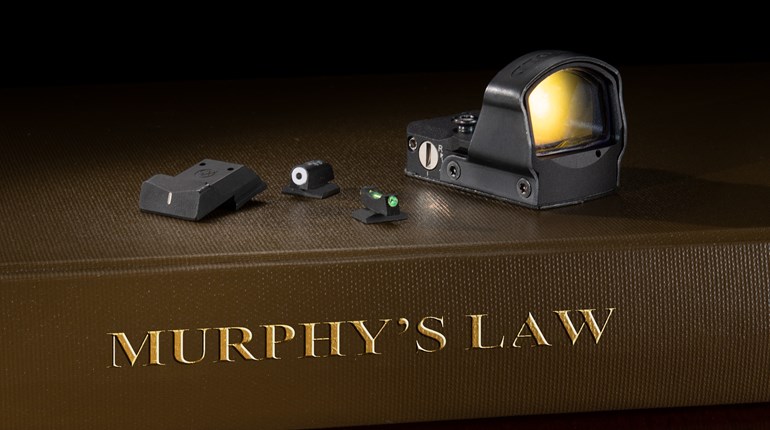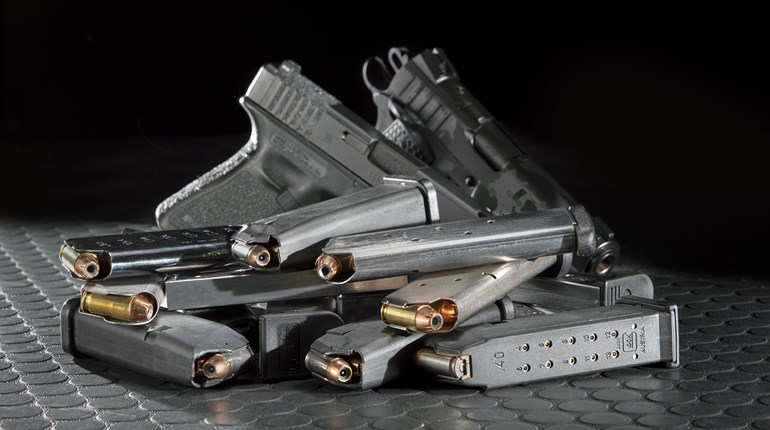
Virtually every carry gun is a compromise, it just depends on which qualities are most important to you. Size and weight are often most critical, as they allow you to have the gun with you most often. Shown is the discontinued Kel-Tec P3AT in front of a Glock G26.
When one’s daily concealed-carry piece is something like a dinky .380 ACP in a pocket holster or a five-shot snubnose revolver in an ankle rig, it’s easy to remember that these firearms are compromises between the First Rule of Gunfights (have a gun) and carrying nothing at all.
Darryl Bolke, retired Southern California deputy and half of the instructor duo at Hardwired Tactical Shooting, refers to these little pieces as “Get out of trouble” guns. This reflects their suitability for the private citizen’s primary mission, which is to thwart an attack and, if possible, break contact, as opposed to the service-size pistols intended for duty carry by people whose job it is to look for and remedy trouble.
When carrying a larger firearm in a dedicated waistband holster, however, it can be easier to forget that there are often compromises that went into the selection of those handguns, too, and it’s worthwhile to remember that they can also have unforeseen limitations and trade-offs.
For instance, one of those trade-offs is reducing the height of a handgun by shortening the grip. When carrying in the strong-side position between 3 o’clock and about 4:30 (using the conventional description of belt positions that puts the wearer’s belly button at 12 o’clock), this reduces the likelihood of the butt of a pistol or revolver making a strange protrusion through the cover garment, especially when seated.
The thing is, if you shorten the grip length too much in this fashion, you measurably reduce the ability to control recoil, especially in rapid fire. Where this is most ironic, at least in my opinion, is when a shortened grip, like a “Boot Grip” is added to a round-butt K- or L-frame Smith & Wesson. Because these grips fill in the space behind the trigger guard for better control in double-action shooting and stop at the bottom of the revolver’s frame for better concealability, you wind up with a revolver that suffers the same two-finger-grip issues as a tiny J-frame, possibly amplified by more potent magnum or big-bore cartridges allowed in a medium-frame wheelgun.
You know that classic saying that you can never be too rich or too thin? Well, that may apply to people, but not so much to pistols.
If there was a peak in 1911 popularity as a carry gun, it might have been in the late 1990s and early 2000s. Striker-fired, polymer-frame guns still hadn’t achieved the ubiquity they have now, the wave of shall-issue concealed-carry legislation was still cresting and the then-extant national ban on standard-capacity magazines made the 1911 pattern an extremely attractive choice for CCW. So did its inherent thinness, being a single-stack pistol.
There’s a principle in custom-handgun work that if some is good, more is better and too much is just enough, and this was applied to the inherent thinness of the classic Government Model. There were thin grip panels, and then even thinner grip panels accompanied by special low-profile grip screws and bushings to support them. Some gunsmiths began doing radical surgery on the frames themselves, either machining the frame to allow the grip panels to be countersunk into it or machining the frame itself to shave some additional hair’s breadth of width.
Never mind that this made the gun harder to control in recoil, especially in rapid fire, for people with large hands. It was thinner and therefore offered some borderline-intangible benefit in concealment. Unless the shooter had very small paws, however, these changes were likely to be an impediment rather than a benefit.
One great advocate of the 1911, legendary trainer Clint Smith, is well known for saying that a carry gun was supposed to be comforting, rather than comfortable. A lesser-known aphorism of his is that people always want to carry the tiniest, lightest gun they can, but when they have to pull it out, they want the biggest frickin’ gun they can hold (and if you’ve ever taken a class with Smith, you know his language was significantly saltier than my paraphrasing).
A common solution to this dichotomy is to make duty-size, or at least duty-ish size, pistols as light as possible. But, there’s definitely such a thing as making a pistol too light.
Returning to that 1911 example, an all-steel Government Model or Combat Commander is fairly mild to fire in .45 ACP, and unbelievably soft-shooting in 9 mm. Replace that steel in the frame with aluminum and the pistol becomes more pleasant to carry, but a lot more work to run well.
Take the weight reductions to extremes, like with titanium-cylinder AirLite revolvers, and recoil becomes enough of an issue that there are weight restrictions placed on bullets. Too heavy of a projectile, and a scandium-frame Smith & Wesson turns into a hand-held kinetic bullet puller. As an extreme example, a Model 325 chambered in .45 ACP can’t run an entire cylinder full of inexpensive FMJ practice ammo without the last couple rounds disassembling themselves in their chambers.
Reducing the height, width or weight of a carry gun may make it more comfortable and concealable, but be aware that too much of a good thing can make for a blaster that’s as much of a compromise between carryability and combat ability as any little .380 ACP pocket gun or five-shot snubby.




































